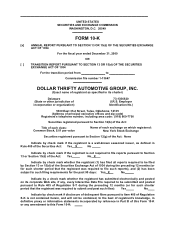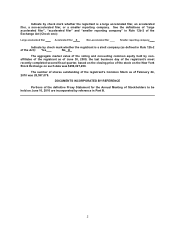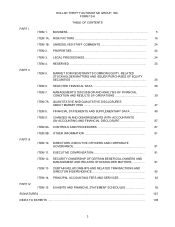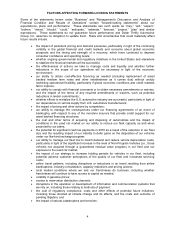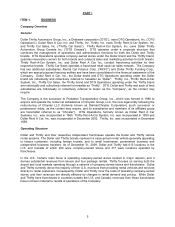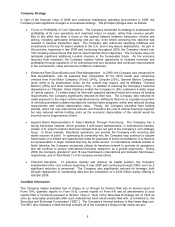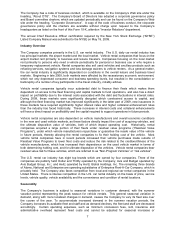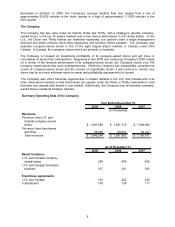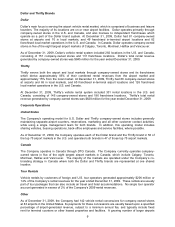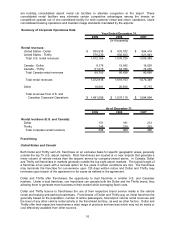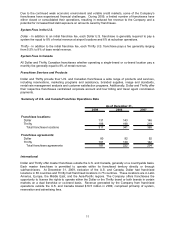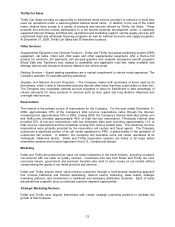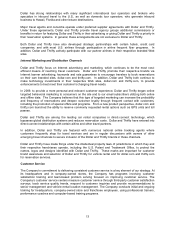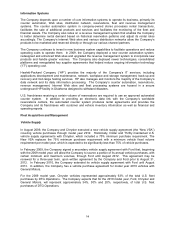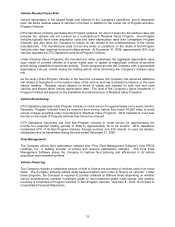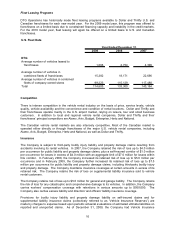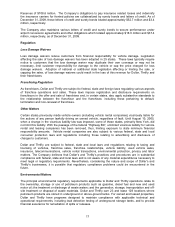Thrifty Car Rental 2009 Annual Report Download - page 8
Download and view the complete annual report
Please find page 8 of the 2009 Thrifty Car Rental annual report below. You can navigate through the pages in the report by either clicking on the pages listed below, or by using the keyword search tool below to find specific information within the annual report.The Company has a code of business conduct, which is available on the Company’s Web site under the
heading, “About DTG”. The Company’s Board of Directors has adopted a corporate governance policy
and Board committee charters, which are updated periodically and can be found on the Company’s Web
site under the heading, “Corporate Governance”. A copy of the code of business conduct, the corporate
governance policy and the charters are available without charge upon request to the Company’s
headquarters as listed on the front of this Form 10-K, attention “Investor Relations” department.
The annual Chief Executive Officer certification required by the New York Stock Exchange (“NYSE”)
Listed Company Manual was submitted to the NYSE on May 19, 2009.
Industry Overview
The Company competes primarily in the U.S. car rental industry. The U.S. daily car rental industry has
two principal markets: the airport market and the local market. Vehicle rental companies that focus on the
airport market rent primarily to business and leisure travelers. Companies focusing on the local market
rent primarily to persons who need a vehicle periodically for personal or business use or who require a
temporary replacement vehicle. Rental companies also sell used vehicles and ancillary products such as
refueling services, navigation systems and loss damage waivers to vehicle renters. As a general matter,
the car rental industry is significantly dependent on conditions in the overall leisure and business travel
markets. Beginning in late 2008, both markets were affected by the recessionary economic environment,
which not only depressed consumer and business spending levels, but resulted in the consolidation or
bankruptcy of a number of key participants in the travel industry, notably airlines.
Vehicle rental companies typically incur substantial debt to finance their fleets which makes them
dependent on access to the fleet financing and capital markets to fund operations, and also has a direct
impact on profitability due to the interest costs associated with the debt and fluctuations in interest rates.
During 2009, these markets were significantly disrupted which constrained access to capital, and
although the fleet financing market has improved significantly in the latter part of 2009, new issuances in
these markets have required significantly higher interest rates and higher collateral enhancement rates
than the industry has faced historically. These increases in interest costs and collateral enhancements
will have a direct impact on profitability and the capital required to support operations in future periods.
Vehicle rental companies are also dependent on vehicle manufacturers and overall economic conditions
in the new and used vehicle markets, as these factors directly impact the cost of acquiring vehicles, and
the ultimate disposition value of vehicles, both of which impact operating cost. Historically, rental
companies acquired a large portion of their fleets under residual value programs (“Residual Value
Programs”), under which vehicle manufacturers repurchase or guarantee the resale value of the vehicle
in future periods, thereby allowing the rental companies to fix their holding cost of the vehicle. Most
vehicle rental companies have in recent periods increased their vehicle purchases made outside of
Residual Value Programs to lower fleet costs and reduce the risk related to the creditworthiness of the
vehicle manufacturers, which has increased their dependence on the used vehicle market in terms of
both determining holding cost, and for ultimate disposition of the vehicles. Vehicle rental companies bear
residual value risk for these vehicles, which are referred to as “Non-Program Vehicles” or “risk vehicles”.
The U.S. rental car industry has eight top brands which are owned by four companies. Three of the
companies are publicly held: Dollar and Thrifty operated by the Company; Avis and Budget operated by
Avis Budget Group, Inc.; and Hertz operated by Hertz Global Holdings, Inc. The remaining three brands
of Alamo, National and Enterprise are operating subsidiaries of Enterprise Rent-A-Car Company, which is
privately held. The Company also faces competition from local and regional car rental companies in the
United States. There is intense competition in the U.S. car rental industry on the basis of price, service
levels, vehicle quality, vehicle availability and the convenience and condition of rental locations.
Seasonality
The Company’s business is subject to seasonal variations in customer demand, with the summer
vacation period representing the peak season for vehicle rentals. This general seasonal variation in
demand, along with more localized changes in demand, causes the Company to vary its fleet size over
the course of the year. To accommodate increased demand in the summer vacation periods, the
Company increases its available fleet and staff and as demand declines, the fleet and staff are decreased
accordingly. Certain operating expenses, such as minimum concession fees, rent, insurance and
administrative overhead represent fixed costs and cannot be adjusted for seasonal increases or
7


